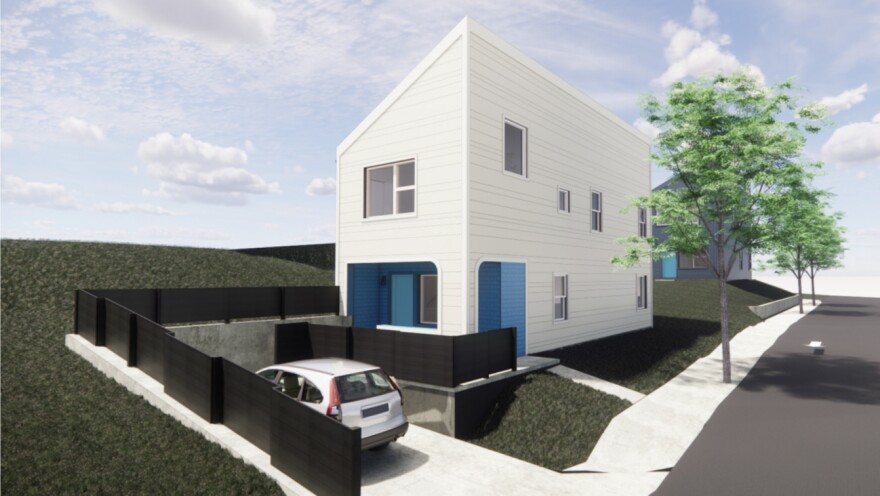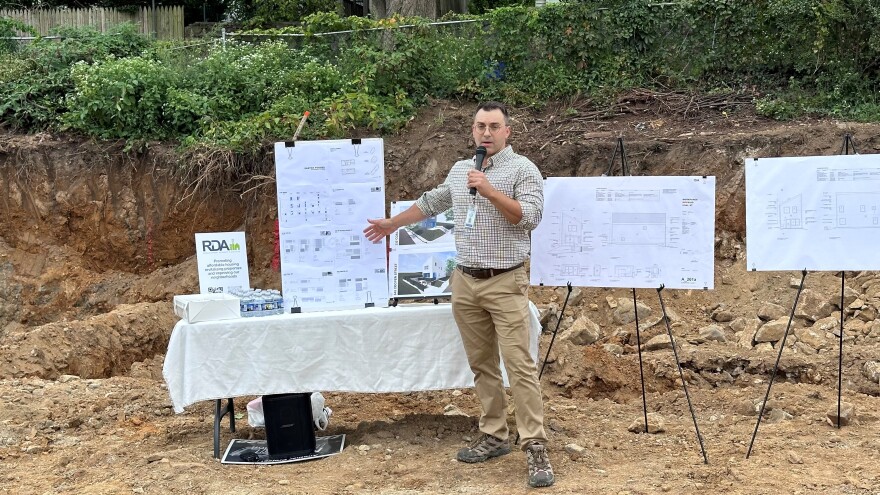EASTON, Pa. — Easton’s Redevelopment Authority showcased the future site of two new “workforce housing” units in the city’s South Side neighborhood Wednesday, with a goal to provide safe and attainable housing for an oft-neglected segment of residents.
The RDA Deputy Director Michael Brett was joined by local and county officials to introduce the project to the public, displaying schematics and renderings of two homes set to be built at the lot on the corner of Coal and West Cooper Streets.
Those are just two of 11 “workforce housing” projects happening around Easton, Brett said, with the intent to help those in the middle income who are struggling to purchase a house in the modern market.
Building a plan for 'workforce housing'
Two years ago, the RDA reached out with a quotation request from a developer which would allow them to create an ideal model home capable of being replicated across the city, regardless of the lot it would be built on.
From there, the RDA explored limitations dictated by zoning, residential criteria, and other details.
“And then after that, we came up with a footprint and a concept, and we had public engagement, where we had members of the community who came together with the architects, with the Redevelopment Authority staff, elected officials and other city staff to hear what is important to Eastern residents,” Brett said.
“What amenities do they need? What flexibility do they need? And how do they want to see the layouts of these houses? How do they see themselves aging in place? And how can these homes serve them, not only for the rest of their lives, but potentially the next generation as well?”
Taking in that information, the RDA “came up with a very sort of modern approach,” as Brett put it, while respecting the aesthetic of the neighborhood.
“And so we ended up with a 17 by 45 foot footprint, which gives us about a 1,350 square foot house, three bedrooms, two full bathrooms,” Brett said.
“The first floor has a centralized kitchen. It allows for flexibility to turn the rear of the house into either a bedroom for aging in place, multi-generational living, an in-home office, or a fourth bedroom. It has ADA visitable capabilities, so all the first floors have proper clearances and turnaround radii for ADA accessibility. So we really tried to design a house that can withstand the test of time and serve our needs in the long term.”

This type of house allows for easy compatibility with numerous lot types, Brett said, adding the Coal Street site will have two homes — 322 Coal Street and 648 Cooper Street — which can be set up as fully attached, semi-detached, or fully detached from one another.
Costs and qualifications
Income for these units will likely be limited to $70,000 for a four-person family, with deed restrictions to ensure affordability for at least 20 years.
Brett said the two houses featured in Wednesday’s presentation would be priced around $175,000 to $200,000, with a market value of approximately $300,000. Buyers’ income must fall below 80% of the median income.
However, similar initiatives under the RDA might broaden access to housing for those who fall within that median income but are unable to afford a mortgage. Brett said some partners may be able to accommodate buyers who earn up to 120% of the median income.
Coal Street Renderings by LehighValley Newsdotcom on Scribd
The houses will be put on the open market, Brett said, though partnerships with Greater Shiloh Church, the Third Street Alliance, and Safe Harbor could assist some buyers if necessary.
The Coal Street houses are intended to be complete by early spring 2025, Brett said.
According to Mayor Sal Panto Jr., $3.9 million of a $20 million ARPA allotment obtained by the city has been dedicated to affordable housing, indicating further projects are on the docket.
Brett pointed out a few of those projects were being built in the West Ward, including four new homes planned for Locust and 7th Streets, three on Center and Berwick Streets, and another two on Wilkes Barre Street.
Using 'OPM' to make housing attainable
RDA member Melissa Lozada — who purchased a house which Brett had worked upon over a decade ago — said she was excited to see the launch of projects like these coming to fruition, “and many more to come.”
“It's been a delight working with the city of Easton, the mayor and the Redevelopment Authority, and I'm really excited to see the next steps of what Easton and the RDA have to offer,” Lozada said.
Panto commended the RDA and county officials who have worked together on the project, making a strong point that “we can’t do it alone.”
“We do it with ‘OPM,’ other people's money, and we go after as much as we can. We need the state government, the federal government, and I'm in Washington and Harrisburg lobbying all the time for affordable housing subsidies, whether it be helping with down payments or closing costs or whatever, because I'm a product of public housing.” Panto said before reminiscing about his childhood on Delaware Terrace, where he lived with his family before they were able to move to a half double on West Milton Street.
Panto said he wanted the youth of today and the future to be able to have a happy childhood which comes from secure housing.
The mayor added his father was able to gain equity from owning a home, eventually flipping that into generational wealth which can greatly assist working class families, filling a need often neglected by the government.

“We have low-income housing. Our housing authority has over 600 units for low-income housing. We don't have anything for the people who work for a living, the middle class who works, and it's all stratas,” Panto said.
Easton City Councilmember Frank Pintabone, who serves on the Blueprint Communities program with Panto, pointed out Easton was in the midst of a “workforce housing” renaissance of sorts, with seven townhomes similar in design to the RDA which are being built on Phillips Street.
Pintabone pointed out the necessity for housing across the spectrum, again, especially in regard to those who fall into the middle-income bracket.
“We need the high-end apartments. We need the affordable apartments. We need the low-income apartments. You can't have one without the other. These projects wouldn't be done without the money coming in, the tax revenue coming in, and the grants being provided by the state and other local agencies. So I appreciate every I appreciate everybody from the private developer to the RDA to the city, to everybody that's investing back in the city of Easton,” Pintabone said.
Northampton County DCED Deputy Director Marek Tomanek applauded the efforts of the city and its partners to find creative solutions to housing accessibility throughout Easton, looking forward to a future where housing is much more attainable for all.
“We know that there's no ‘one size fits all’ when it comes to affordable housing and attainable housing,” Tomanek said.
“Up the street, 50 units of affordable rental housing, fantastic. It can be a quality housing situation for folks who need it, but also, you're looking for homeownership, like the mayor mentioned, building wealth allows people to rise above, and that's what these situations will cause.”


